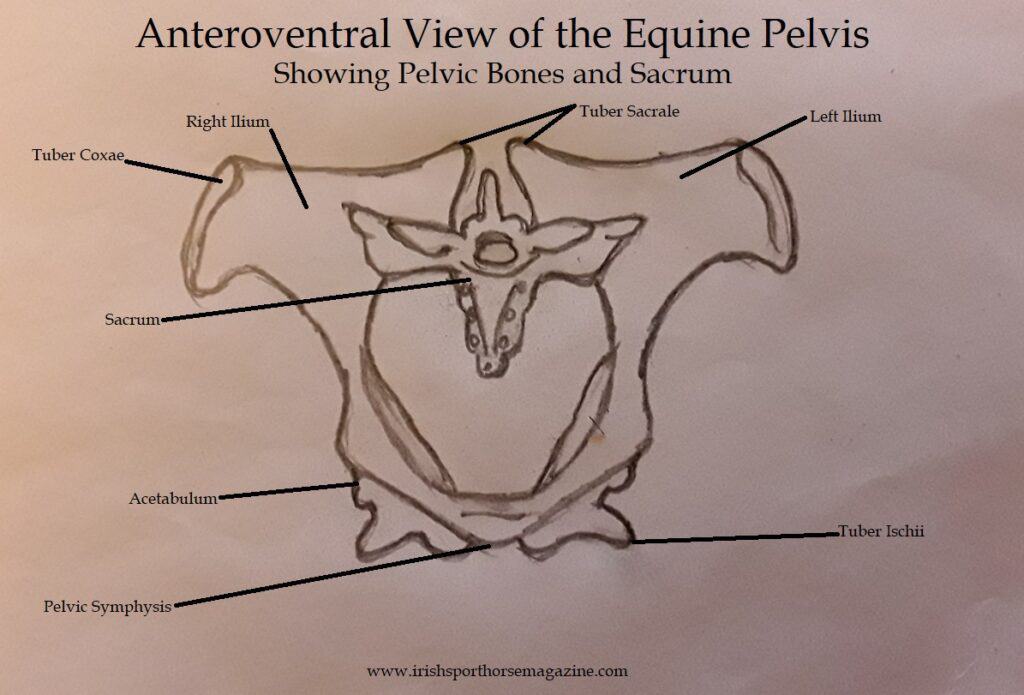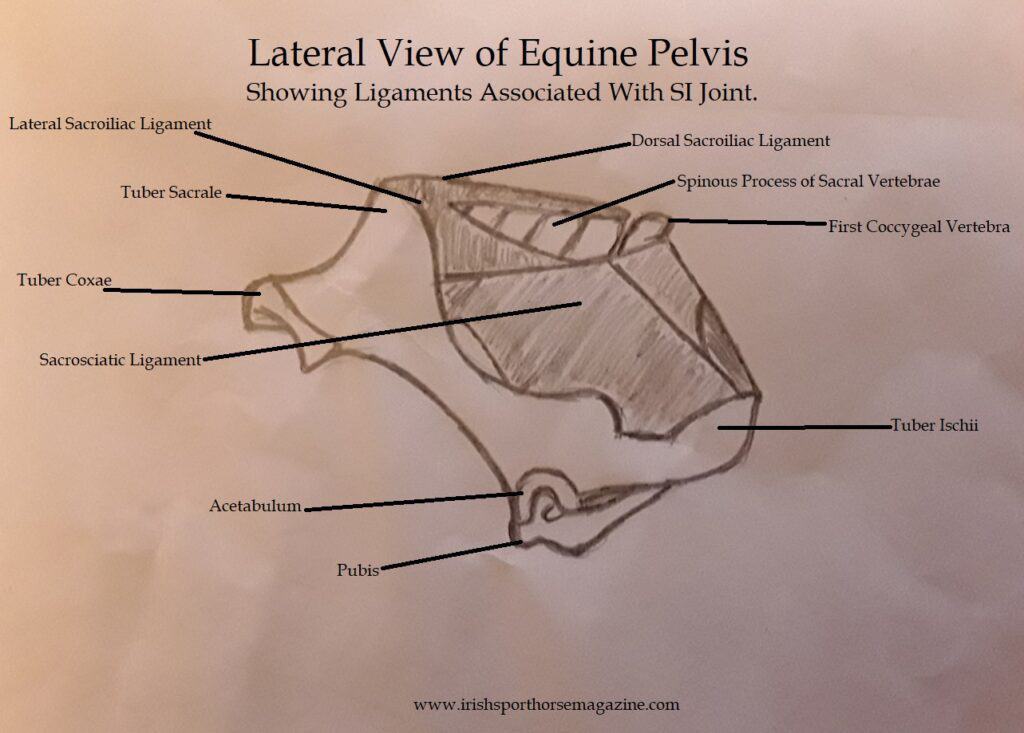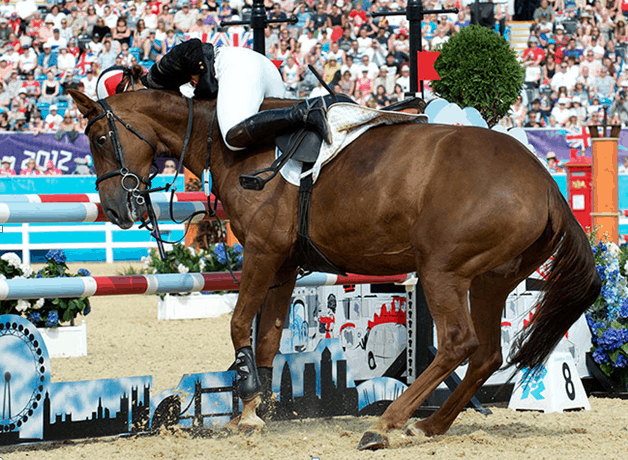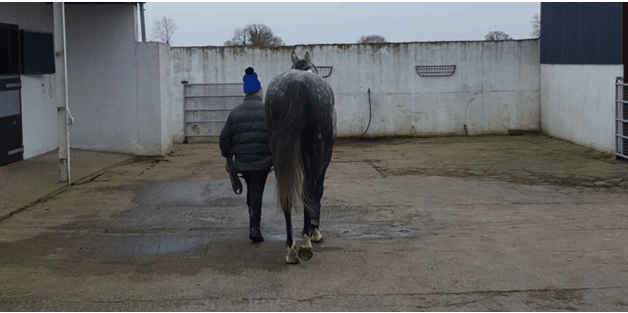The Sacroiliac Joints are two of the most important joints of the horse’s body. The correct function of the SI Joint is of particular importance to the competition horse, because if the function of either SI Joint is impaired in any way it will have a direct effect on your horse’s performance.
What is the Sacroiliac Joint?

There are two Sacroiliac Joints, one located either side of the pelvis and their function is to secure the horse’s pelvis to the axial skeleton. These joints are also responsible for the transfer of the propulsive and concussive forces of the hind limb to the animal’s vertebral column.
The SI Joint is formed between the ventral aspect of each Ilium (hip Bone) and the Dorsal Lateral Aspect of side of the Sacrum(the triangular bone situated just after the lumbar vertebrae) , see the diagram above. The Equine pelvis is attached to the Axial skeleton via the SI joints and the Sacroiliac and Sacrosciatic ligaments.
The joint surfaces are almost completely flat, and the joint is held together and supported by a 3 sets of ligaments; the dorsal, interosseus and ventral sacroiliac ligaments, allowing for very little movement within the joint.
Why is The SI Joint Important to the Competition Horse?
The SI Joints have a very important role in the transfer of the propulsive forces of the horse’s hind limb to the vertebral column. As equestrians, we are constantly training our horses to take more of their weight through their hind leg. The reasons for this is that the hind end is the engine of the horse, when we train the horse to engage his hind limb, it enables him not only to lighten the concussive forces on the forelimb, but to also have more strength and impulsion coming from behind, making his job of carrying the rider throughout his sporting life that bit easier.

In a study of 74 horses with pain in the SI Joint Region it was found that Dressage Horses and Showjumpers appeared to be at a greater risk, with Warm blood Horses proving to be more susceptible to problems in the region.(S.Dyson et al 2003)
In Equestrian Sport injuries can happen no matter how correct the training. With horses the chance of injury occurring either during time off or during training; falls or knocks during competition, along with any problems that stem from rider imbalance or asymmetry is very high. Therefore it is important to know the signs and symptoms of the earliest onset of Sacroiliac Problems so that action can be taken to prevent further damage, while allowing the horse the best possible chance to heal.
Symptoms of SI Joint Pain.
The symptoms of SI Joint pain are not always as obvious as one might think. Often the initial symptom is loss of performance; here I have listed some of the most common documented symptoms;
Loss of Performance is one of the most Common Symptoms of Sacroiliac Joint Problems.
- Loss of performance
- Low Grade hind leg lameness
- Lack of Impulsion
- Slower limb flight or dragging toe of the affected limb
- Stopping/refusing fences
- Reluctance to move forward
- Knocking or Jumping flat
- Problems with one canter lead
- Disuniting or bunny hopping in the canter
- Horse’s symptoms are worse under saddle
- General stiffness in the back
- Bucking or kicking out while being ridden
- Uneven Tuber Sacrale; (can indicate a problem, but studies have proven it is not always the case)
- Muscle wastage over the affected quarter in chronic cases
- Farrier may complain that the horse is difficult to shoe behind

NB**I have witnessed in very acute cases, i.e. where a horse has either had a bad fall or hit a cross country fence, that hind leg lameness is very pronounced, and is worse when the horse is lunged with the affected limb on the inside of the circle; with the horse appearing almost sound when lunged with the unaffected limb on the inside of the circle.
- Also in Acute cases there is often pain and swelling on the affected side, in the region of the croup due to soft tissue damage associated with injury.
Diagnosis of SI Joint Pain
The diagnosis of an SI Joint Problem is often quite difficult if the animal has a more chronic condition.
The diagnosis therefore is made by a process of elimination, i.e., ruling out other possible causes of hind limb lameness from lower down the hind limb, such as in the stifle or the hock, or pain due to impingement of nerves in the Lumbar Region.
Here are the initial steps your Vet may take;
1 Assess your horse your horse at rest, check to see if there is any obvious reason for the lameness lower down the limb; is there stiffness or pain on flexion of the hock or stifle. Check for any obvious bumps or swelling.
2 Palpate over the area of the croup, if there is an acute injury this area may be tender and swollen. If the injury is more chronic, there may be no obvious reaction from the horse.
3 In more chronic cases there is often muscle wastage over the quarter of the affected limb, with increased muscle tension and spasm on the opposite quarter.
4. Direct pressure downward over the area of the Croup is said to stress the SI Joint and may cause a positive pain response. Care should be taken with this test as a horse with an acute injury may have a very dramatic response to this test and completely lose control of the hind limbs. Therefore this test should be administered gradually.
5. The vet will assess the horse moving usually in straight lines and on the lunge.
6. The vet will use local anaesthetic in attempt to block pain from the area. If the SI Joint is the problem, the animal’s symptoms will improve.

Relevant Imaging for SI Joint
Imaging to aid the diagnosis can be difficult due to the deep location of the joint. These are the methods often used
- Nuclear Scintigraphy is a method used to aid in the diagnosis of SI Joint Problems. The radioactive substance is injected into the horse and this will gather in areas of new bone growth, such as the beginnings of an arthritic condition. Imaging is then taken of the area using a Gamma Camera.
- Transrectal Ultrasonography is also used to image the joint, to look for abnormalities.
- Ultra sound and Radiographs have also been used.
Treatment Options
If your horse is diagnosed with SI joint problem the treatment will depend on the severity of the injury.
- Depending on the severity of the problem rest is prescribed for a period of 30 to 60 days.
- A very small paddock with good footing is preferable; although with a severe acute injury box rest for 30 – 45 days may be required to allow damaged ligaments time to heal.
- Injections of pain relief and anti-inflammatory drugs are usually administered.
- On returning to work a slow gradual build up is suggested, long reining for a time until the area is strengthened up.
- Fittening the horse through hacking in straight lines, I believe gives the joint the best possible chance for a complete recovery, only returning to work on circles when the horse is fit and strong and muscled up.
- If at any stage the horse seems to be reluctant to work, slow things down and return to straight line work.
- Keeping the horses feet well balanced is a must, especially during recovery.
- Chiropractic, Physio and Acupuncture can all prove beneficial in keeping the horse comfortable and flexible as he recovers.
- When the horse returns to full work, ensure that the work is varied with plenty of hacking to minimize the repetitive stress on the joint.
In conclusion
As with any injury, prevention is better than cure. A good fittening program is essential to the horse, this plus a varied routine with plenty of slow steady hacking is also beneficial. When schooling the horse it is important to give plenty of walks on a long rein in between periods of intense work.
Last but by no means least, listen to your horse, generally if they have a loss of performance there is usually something bothering them. Take your time and find out the cause. Your patience and understanding will make a world of difference to your horse.
This Article was originally published in the December 2019 Issue of Irish Sport Horse Magazine.
References;
Haussler, Kevin. (2003). Diagnosis and Management of Sacroiliac Joint Injuries. 10.1016/B978-0-7216-8342-3.50060-7.
S.Dyson, R.Murray (Equine Vet J. 2003 May;35(3):240-5.)Pain associated with the sacroiliac joint region: a clinical study of 74 horses.
A Barstow, S. Dyson (2015)Clinical features and diagnosis of sacroiliac joint region pain in 296 horses: 2004–2014
Smythe & Goody – Horse Structure & Movement
